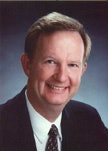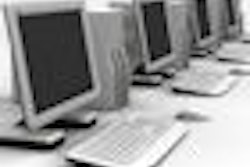
How should a typical dental practice set up its network? Dr. Larry Emmott, D.D.S., a PC guru and principal at the Aesthetic Dental Institute in Phoenix, shared his hard-won insights at the recent American Dental Association meeting in San Francisco.
 |
| Dr. Larry Emmott, PC guru |
Dr. Emmott recommended a client-server model, starting with a powerful server running the Windows 2003 operating system that stores the practice's data.
A RAID 1 server typically costs about $3,000 and offers the best mix of value and redundancy. The server comes with two drives; data on one drive is constantly duplicated or "mirrored" on the other. If one drive fails, the other one instantly takes over, ensuring that your network doesn't suffer any downtime or data loss. Just don't go overboard -- Dr. Emmott heard a vendor quote a dental practice $7,500 for a RAID 5 server, which offers far more capacity and redundancy than the dentist needed.
For the less powerful client computers, Dr. Emmott believes in buying only as much horsepower as the task requires. Chairside computers should have enough oomph to run multimedia applications for patient education and to enable you to edit and otherwise manipulate audio and video. For that, you'll need a system with at least 1 GB of RAM, a midrange video card (like a 128 MB ATI Radeon card), two monitors, a standard sound card (akin to SoundBlaster Audigy SE), and a dual-core CPU. Don't worry about the size of the computer's hard drive, Emmott said. Data will be stored on the server, so pick the smallest hard drive the PC comes with. Multimedia-capable PCs with the above setup can easily be had for $1500 and up.
Computers used by front desk staff for scheduling and billing can be less-powerful systems, with 512 MB of RAM; no video or sound capability is necessary. These PCs typically cost $500 to $1,000. Dr. Emmott recommended that all computers run Windows XP Professional, since the new Windows Vista operating system hasn't proved its stability. Another reason to wait: Many dental practice management and record keeping programs aren't compatible with Windows Vista.
Other necessary computer hardware and software for a medium-sized dental office includes a 12-port network hub ($400 or less) and network interface cards ($35 or less a pop), Cat 5 network cabling (typically $150 to $200 per connection, or "drop"), computer carts for the chairside systems (around $300), the cost of general business and dental software, plus other peripherals and accessories. All told, a practice can spend $15,000 to $20,000 initially for computerization.
One problem with computer technology is that it's obsolete the day you buy it. So plan to replace your equipment every three to four years -- an eventuality that even penny-pinching dentists must accept, Dr. Emmott said.
But you don't have to replace everything at once. Dr. Emmott recommended a replacement cycle in which a couple computers are replaced every year and cycled through the organization, with the dentist's high-end chairside computer being passed down to the hygienist one year and the front office personnel the next.
In addition to being networked, all computers in the dental practice should be connected to the Internet. Some dentists may be concerned that staff will waste time idly surfing the Web. But the benefits of Internet connectivity far outweigh the disadvantages, Emmott said.
Protect that data!
But aren't dental practices that convert to computerized operations putting all their eggs in one leaky digital basket? What about computer crashes, hackers, and natural disasters wiping out your data?
Dr. Emmott is big on backing up data. His preferred method? Backing up your various PCs to a removable hard drive or a portable hard drive connected via USB port. A practice should back up that day's data every day, which makes it easier to restore data in case your PCs or servers are corrupted by a virus or hacker.
Intriguing backup alternatives include offsite storage services (such as Iron Mountain) that back up a practice's data via an Internet connection. These companies also have heavy-duty antivirus and antihacking software that will protect your data far better than any consumer product. The big downside? The big cost. These firms charge per GB of data stored, which can run the typical office hundreds of dollars per month, Dr. Emmott said.
Whether or not you use a third-party service, mirrored hard drives, or simply burn backups to DVD, make sure your backups -- or copies of them -- are stored off site. Dr. Emmott told the story of an oral surgeon's office that was the victim of a break-in, with thieves making off with all the practice's computers -- and all its data.
Dr. Emmott recommended that practices use local firms for IT service and support. Computer technology is a mission-critical feature of the modern dental practice, and you need someone who can be there within hours of an emergency.
Dr. Emmott concluded by reiterating that technology is a means to an end -- better patient care. The practices that implement computer technology well can fundamentally improve their relationships with patients.
"Our patients want us to be high tech, they want us to be up to date, they want us to be using the latest things, they want us to be technoperfect," Dr. Emmott said. But bottom line, they want a relationship. "They want to be known, recognized, and valued as individual human beings. They crave high touch. It's not about bits and bytes and data, it is about the human system."
Copyright © 2007 DrBicuspid.com



















